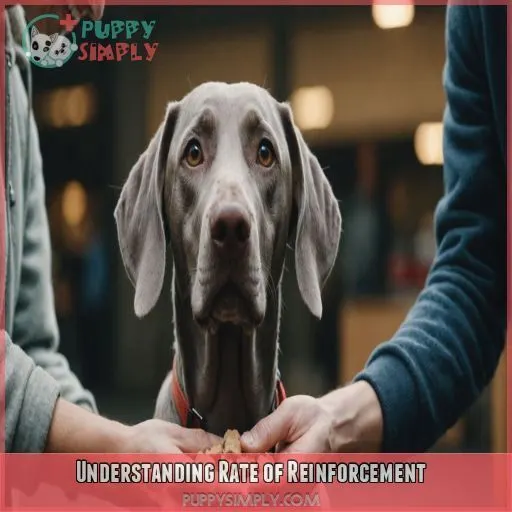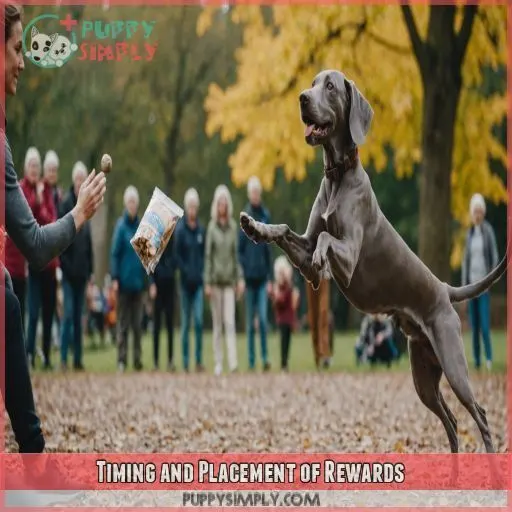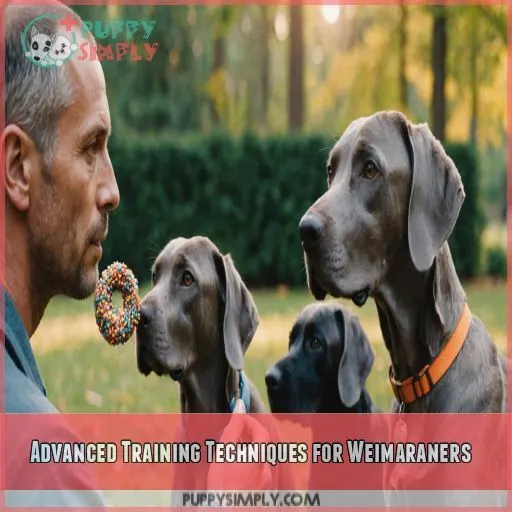This site is supported by our readers. We may earn a commission, at no cost to you, if you purchase through links.

Start by tailoring rewards to your Weimaraner’s preferences, whether it’s treats, toys, or an epic game of fetch.
Create a reward hierarchy, saving the best for tougher training moments.
Keep an eye on age and experience; puppies might require more frequent rewards.
Avoid the rewards they dislike—think of it like skipping that one song you can’t stand.
Now, ready to discover deeper techniques for these spirited companions? Stay tuned!
Table Of Contents
- Key Takeaways
- Choosing Rewards for Weimaraners
- Understanding Rate of Reinforcement
- Timing and Placement of Rewards
- Weimaraner-Specific Training Challenges
- Benefits of Reward-Based Training for Weimaraners
- Common Behavioral Challenges in Weimaraners
- Advanced Training Techniques for Weimaraners
- Frequently Asked Questions (FAQs)
- Why are Weimaraners hard to train?
- What is the best reward for dog training?
- What is the best training for Weimaraners?
- How to tire out a Weimaraner?
- How to maintain reward consistency in cluster training?
- Can cluster training address Weimaraner aggression issues?
- What is the ideal training session length for Weimaraners?
- How to transition from treats to praise in training?
- Can cluster training improve socialization with other pets?
- Conclusion
Key Takeaways
- Tailor rewards to your Weimaraner’s unique preferences—treats, toys, or energetic play—to keep them engaged and enthusiastic during training.
- Create a reward hierarchy, saving the best rewards for tougher training moments, and adjust reinforcement rates as your Weimaraner progresses to maintain their focus.
- Use a marker signal, such as a clicker, to precisely time rewards and reinforce the desired behavior, while avoiding rewarding unwanted behaviors.
- Leverage your Weimaraner’s high energy and enthusiasm by transforming training into a fun, dynamic game that strengthens your bond and addresses common behavioral challenges.
Choosing Rewards for Weimaraners
When training your Weimaraner, choosing the right rewards is key to keeping their attention and enthusiasm high. You don’t always need a treat—sometimes a fun toy or an energetic game of fetch is just what they need to get their tail wagging like crazy.
Tailoring Rewards to Your Weimaraner’s Preferences
Understanding your Weimaraner’s reward preferences is like figuring out their personal treasure chest. Discover their favorites by watching their reactions. Here’s how:
- Food Motivators: Satisfy their taste buds.
- Favorite Toys: Keep these handy.
- Treat Hierarchy: Rank treats from meh to wow!
- Reward Variety: Mix it up to keep training exciting.
Every Weimaraner is unique, exploit their fondness to boost training success!
Using Praise, Toys, and Play as Rewards
You’ve figured out your Weimaraner’s play preferences, but what’s next?
Don’t just stick to treats!
Some Weimaraners go gaga over toys or a spirited game of fetch.
Using toy motivation or a bit of praise can turn training into play-based fun.
Plus, reward timing is key.
A simple "Good dog!" mixed with play can work wonders for those dog tricks.
Creating a Reward Hierarchy for Effective Training
If you’re training your high-energy Weimaraner, creating a reward hierarchy is key. Rank your pup’s favorite things from most to least exciting – treats, toys, play, and praise. This allows you to save the best rewards for those tricky training moments when you really need to capture their attention. Experiment to find what motivates your Weim the most!
- Treats
- Toys
- Play
- Praise
Avoiding Rewards Your Weimaraner Dislikes
Even though you might think all treats are equal, your Weimaraner might disagree! Avoiding rewards your Weimaraner dislikes can boost training success. Here’s a cheat sheet:
| Reward | Alternative Option |
|---|---|
| Treats | Positive Reinforcement |
| Toys | Reward Alternatives |
| Praise | Crate Training |
Understanding Rate of Reinforcement
In the whirlwind of high energy that’s your Weimaraner, keeping their focus can feel like a magic trick. By thoughtfully timing and adjusting your rewards, you can become the master of their attention amidst all the delightful distractions.
Environmental Distractions and Training Rewards
Distraction-proof training is your new best friend when working with Weimaraners, those energetic dynamos.
Picture it: you’re the ringmaster in a circus of distractions!
Keep reward timing sharp as a tack to refocus your dog.
Balance reward value wisely, like the perfect cup of coffee, to outshine distractions.
Trust me; consistency is key to making training a walk in the park.
Frequent Reinforcement for High-Energy Breeds
With a high-energy breed like the Weimaraner, you’ll need to reward frequently at first to make training more exciting than their environment.
You’ll need to dole out treats, praise, and play liberally to keep your pup focused.
Consistency is key – your dog needs to clearly understand the connection between their behavior and the reward.
Adjusting Reinforcement Rates as Your Weimaraner Progresses
Your Weimaraner’s learning pace will change, so adjust reinforcements as they grow more skilled. It’s like playing a game: easy levels mean frequent rewards; as you advance, rewards thin out. This gradual reduction, or reward fading, keeps them engaged. Stay consistent as you phase rewards out—because, hey, even our moody Weimaraners appreciate a balanced training pattern!
Considering Age and Experience in Reinforcement
As you adjust reinforcement rates, don’t forget that age and experience matter. Puppies need frequent treats, like toddlers craving snacks! Adults, with a bit of training under their belts, can hold out for a bigger payoff. Consistency matters, so keep the reward hierarchy in mind. Tailor your approach to their experience level and watch their training goals soar!
Timing and Placement of Rewards
Timing is everything in rewarding your Weimaraner during training. Deliver those treats lightning-fast after your pup nails that behavior, and use a handy marker signal to make sure they know exactly what they’re being rewarded for.
Delivering Rewards Quickly After Desired Behavior
When training your Weimaraner, timing matters! To nail reward delivery:
- Give treats immediately after the desired behavior. Delay, and Fido’s left wondering if it’s for the trick—or that quirky head tilt!
- Stick with positive reinforcement; consistency is key.
- You can use your voice for praise.
- Rewards should reinforce—not complicate—to build trust. Mix it up, and watch skills soar!
Using Marker Signals for Improved Timing
Acting quicker than a cat on a hot tin roof when rewarding behavior is essential. Enter marker signals. Think of clicker training as your secret weapon: it marks the exact behavior you want like a laser pointer. Dont let clicker errors distract you; keep timing sharp for positive reinforcement. Your Weimaraner will strut its stuff like a pro!
Practicing Consistent Marker Signals
Consistently using a marker signal, like a clicker or whistle, is key to improving your Weimaraner’s training. It helps them quickly associate the desired behavior with the reward. Regularly practice the marker signal, trying different variations to keep your pup engaged. Consistent use reinforces the connection, making training more efficient and enjoyable for both of you.
Avoiding Rewards for Unwanted Behaviors
Timing and placement of rewards are very important to successful training. If you accidentally reinforce unwanted behaviors, you’ll confuse your dog about what earns rewards.
Let’s say you reward your Weimaraner after they’ve stood up from sitting. They’ll think the reward is for standing, not sitting. Or, if you let them outside every time they bark, you’re rewarding the behavior you want to stop.
The fix? Be mindful of what behaviors you’re rewarding.
It’s not just about timing. It’s also about what you’re rewarding. Remember, dogs only repeat behaviors that benefit them. If a behavior persists, it’s because your dog gets something out of it.
So, if your Weimaraner jumps on you for attention, they’re getting what they want. If they chew your shoes, it’s fun for them.
To break these habits, you need to remove the reward. If jumping no longer gets them attention, and chewing shoes becomes boring, they’ll stop.
But don’t ignore the behavior. That can cause frustration and aggression. Instead, redirect their energy into something positive. When all four paws are on the floor, give them love. If they’re chewing shoes, offer a toy instead.
Weimaraner-Specific Training Challenges
Training a Weimaraner can feel like juggling flaming bowling pins—they’re high-energy with unique challenges like separation anxiety and a knack for chewing anything in sight. But don’t worry, with a bit of patience and the right strategies, you’ll have your energetic pup respecting boundaries and even strutting confidently at dog shows!
Addressing High Energy Levels in Training
Training a Weimaraner is like managing a whirlwind—energetic and enthusiastic! Channel this exuberance with engaging exercises that capture their attention and outshine distractions. Use their high energy to your advantage—transform it into focus with activities they love. Toss in some humor; think of it as a "get-in-shape" session for both of you! Keep it dynamic, keep them engaged.
Managing Separation Anxiety in Weimaraners
As a devoted Weimaraner owner, you know their strong attachment can lead to separation anxiety. By gradually desensitizing your pup to alone time through crate training and calming techniques, you can ease their stress. Start small, reward calm behavior, and be patient – with time, your Weimaraner will learn to embrace their independence.
Redirecting Chewing Instincts in Weimaraners
To tackle separation anxiety, you’ve kennel trained your Weimaraner. Now, let’s address those pesky chewing habits. Weimaraners often chew rocks, which can lead to tooth damage. Here’s how to redirect their instincts:
- Safe chew toys: Stock up!
- Alternative outlets: Try puzzles or fetch games.
- Rock chewing prevention: Consider muzzle training if other methods fail.
Keep it all fun and exciting!
Handling Young Weimaraners at Dog Shows
A young Weimaraner’s urge to chew can be redirected to success in the show ring. Think of showtime like a dance-off! Practice "ring manners" with socialization and playful handling tips. Always have stress management tricks up your sleeve. Here’s a handy guide:
| Task | Strategy |
|---|---|
| Puppy show prep | Early exposure |
| Socialization | Meet & greet |
| Handling tips | Gentle touch |
| Stress management | Relaxing cues |
Make sure those paws prance with confidence!
Benefits of Reward-Based Training for Weimaraners
Reward-based training will turn your energetic Weimaraner into a willing learner while also making you their favorite human in the process. By transforming challenges into bonding opportunities, you’ll tackle behavioral hiccups but also set the stage for a well-rounded, happy hound.
Encouraging a Love of Learning in Weimaraners
Weimaraners are born to learn, and reward-based training taps into their natural curiosity.
By making training an engaging game with their favorite treats, toys, and praise, you’ll ignite their love of learning.
Clicker training is especially effective, as it allows you to precisely mark desired behaviors.
With patience and creativity, you can transform training into a fun bonding experience for you and your Weimaraner.
Strengthening the Bond Between You and Your Weimaraner
Your Weimaraner’s happy tail wagging is a sign you’re doing something right! Strengthen that bond with playtime and trust-building:
- Socialization tips: Explore new places and faces!
- Dog park etiquette: Practice patience and positivity.
- Positive reinforcement: Use praise and play for well-done tricks.
- Consistent routines: Keep a rhythm dogs love predictability!
Addressing Behavioral Issues With Reward-Based Training
Building a strong bond with your Weimaraner isn’t just about cuddles. It’s about using reward-based methods to tackle those pesky behavioral challenges. Positive reinforcement is your secret weapon here. It’s like having cake and eating it too! By celebrating good behavior with treats or praises, you’re not just training; you’re creating a harmonious dog-owner relationship.
Improving Generalization of Behaviors in Weimaraners
Shaping behaviors in Weimaraners isn’t just about tricks; it’s about consistency conquering chaos. Train them in diverse environments, from living rooms to bustling parks. This aids generalization, so "sit" means "sit" anywhere. Use cues amidst distractions—real-world scenarios make them pros. Keep it engaging and remember, perseverance is your secret weapon. Who said training can’t be ruff-ly fun?
Common Behavioral Challenges in Weimaraners
As a Weimaraner owner, you know these energetic pups can be a handful. From demand barking to disobedience, we’ll take a closer look at the common behavioral challenges you may face and share expert tips to tackle them head-on.
Demand Barking and How to Address It
Identifying triggers for demand barking can feel like finding a needle in a haystack. Be patient and consistently outsmart your Weimaraner with these tips:
- Ignore barking – It’s tough, but it works!
- Set consistent rules – No double standards.
- Reward silence – Praise them for the hush.
- Provide alternative attention – A little distraction can be a game-changer.
Enforcing Commands and Reducing Disobedience
Shifting from demand barking to command enforcement takes consistency and clear rules. Imagine your Weimaraner as a stubborn mule. Listen upapproach with timing and rewards in sync. Establish consequences for disobedience, and dont let commands fade into thin air. Remember, patience and consistent practice transform chaos into cooperation. Youre the leader; let your loyal partner follow suit effectively!
Using the Reverse Sit Exercise for Hyperactive Weimaraners
After successfully enforcing commands, tackle hyperactivity with the Reverse Sit Exercise. Weimaraners can be like a whirlwind in the living room. Here’s how to harness that energy:
- Quickly step away when they seem restless.
- Use Reverse Sit Variations to surprise them.
- Control doorways by practicing sit before guests arrive.
- Maintain training consistency for energy release.
Ready, set, sit!
Kennel Training for Separation Anxiety
Just like mastering the Reverse Sit with your hyperactive Weimaraner, kennel training can help tackle separation anxiety. Think of it as creating your dog’s personal day spa—a cozy, safe haven. Start small, using high-value treats to encourage your pup inside, leaving the door open at first. Over time, this "spa moment" reduces crate anxiety, making alone time zen-like.
Advanced Training Techniques for Weimaraners
In advanced training with your energetic Weimaraner, you’ll want to use high-value rewards to make mastering complex behaviors exciting. By gradually increasing reinforcement rates, you can keep your furry dynamo focused and keen to learn, even if their energy sometimes seems to outpace the laws of physics!
Gradually Increasing Reinforcement Rates
So, you want your Weimaraner to be a superstar? Start by fine-tuning that reward schedule. Gradually fading rewards while shaping behavior keeps your pup engaged. Picture clicker training as the maestro of this orchestra. Positive reinforcement? That’s your secret sauce. Ease up on treats as they nail commands, and soon, your pup will be the Einstein of obedience!
Using High-Value Rewards for Complex Behaviors
As your Weimaraner masters the basics, it’s time to up the ante with high-value rewards for more complex behaviors.
Think treats they go wild for, like cooked chicken or cheese.
Use these special rewards to shape desired actions through successive approximations.
Food puzzles can also boost motivation for advanced training.
Just be sure to adjust your reinforcement schedule as your pup progresses.
Practicing Advanced Obedience Commands
When practicing advanced commands with your Weimaraner, picture yourself as a maestro conducting a symphony. Off-leash control is your crescendo; it requires patience and precision. Start amid controlled distractions, gradually introducing real-life scenarios. Troubleshoot like a detective—adjust techniques until your dog shines like the star it is. Remember, persistence is your baton; wield it wisely to orchestrate success.
Addressing Advanced Behavioral Challenges in Weimaraners
Sometimes a Weimaraner’s boundless energy feels like controlling a tornado in a teacup! Address leash pulling by being a tree—stop when they tug. Tackle jumping with "paws-off" practice and rewarding calm behavior. For food guarding, stay calm and swap guarded items with tasty treats. Use crate training to combat separation anxiety. Remember, patience and humor help tackle these challenges!
Frequently Asked Questions (FAQs)
Why are Weimaraners hard to train?
Weimaraners are a bundle of energy – they’re like a tornado in a dog suit! Their high drive and attachment issues can make training a real challenge. But with patience and the right rewards, you can channel that boundless enthusiasm into obedience.
What is the best reward for dog training?
The best reward for dog training depends on your pup, and choosing the right dog clippers choosing the right dog clippers is just as important for a smooth grooming experience
. Some dogs will do flips for treats, others might prefer a belly rub or their favorite toy. Find what makes their tail wag and keep training fun!
What is the best training for Weimaraners?
Ever notice how Weimaraners are like furry tornadoes? You’ll want training packed with mental puzzles, reward-based techniques, and lots of physical activity. Channel their energy into agility or scent work for a happy, well-adjusted companion.
How to tire out a Weimaraner?
To tire out your energetic Weimaraner, engage them in vigorous activities like agility courses, fetch, or long hikes. Mix it up with mental challenges too—think puzzle toys or training exercises. Keep them busy and they’ll snooze like a log!
How to maintain reward consistency in cluster training?
Keep reward consistency in cluster training by using your dog’s favorite treat as a jackpot reward and learn about Weimaraner training needs.
. Mark the exact behavior with a clicker, then toss the treat quickly. It’s like the dog lottery—big win for great behavior!
Can cluster training address Weimaraner aggression issues?
Taming aggression in Weimaraners is like turning down a relentless tidal wave; use cluster training techniques to reinforce calm behavior patterns.
. Keep sessions short, sweet, and rewarding. Master patience and consistency to lead your strong-willed friend with grace.
What is the ideal training session length for Weimaraners?
For training sessions with your energetic Weimaraner, aim for 10-15 minutes. Keep it snappy and engaging to match their attention span. Think of it as a brisk jog—fast-paced, focused, and rewarding for both of you!
How to transition from treats to praise in training?
Start by pairing treats with praise simultaneously. Gradually reduce treats while keeping the praise lively—like a cheerleader at a pep rally. Your dog will eventually wag its tail for praise alone, mastering their skills with enthusiasm.
Can cluster training improve socialization with other pets?
Cluster training, like throwing a social butterfly into a pet party, can indeed enhance your dog’s mingling skills. It encourages trust and good vibes with other pets by rewarding positive interactions, creating a harmonious pet haven.
Conclusion
Isn’t it interesting how mastering Weimaraner cluster training rewards resembles crafting the perfect musical mix?
By understanding their unique preferences and refining your approach, you’re not just teaching commands, you’re dancing in sync with your dog’s energetic spirit.
With these specific strategies, you’ll communicate effectively, turning challenges into triumphs.
So, grab your reward playlist and start orchestrating success with your Weimaraner, ensuring training sessions are as lively and engaging as a joyful tune.
You’ve got the tools; it’s time to jam!













